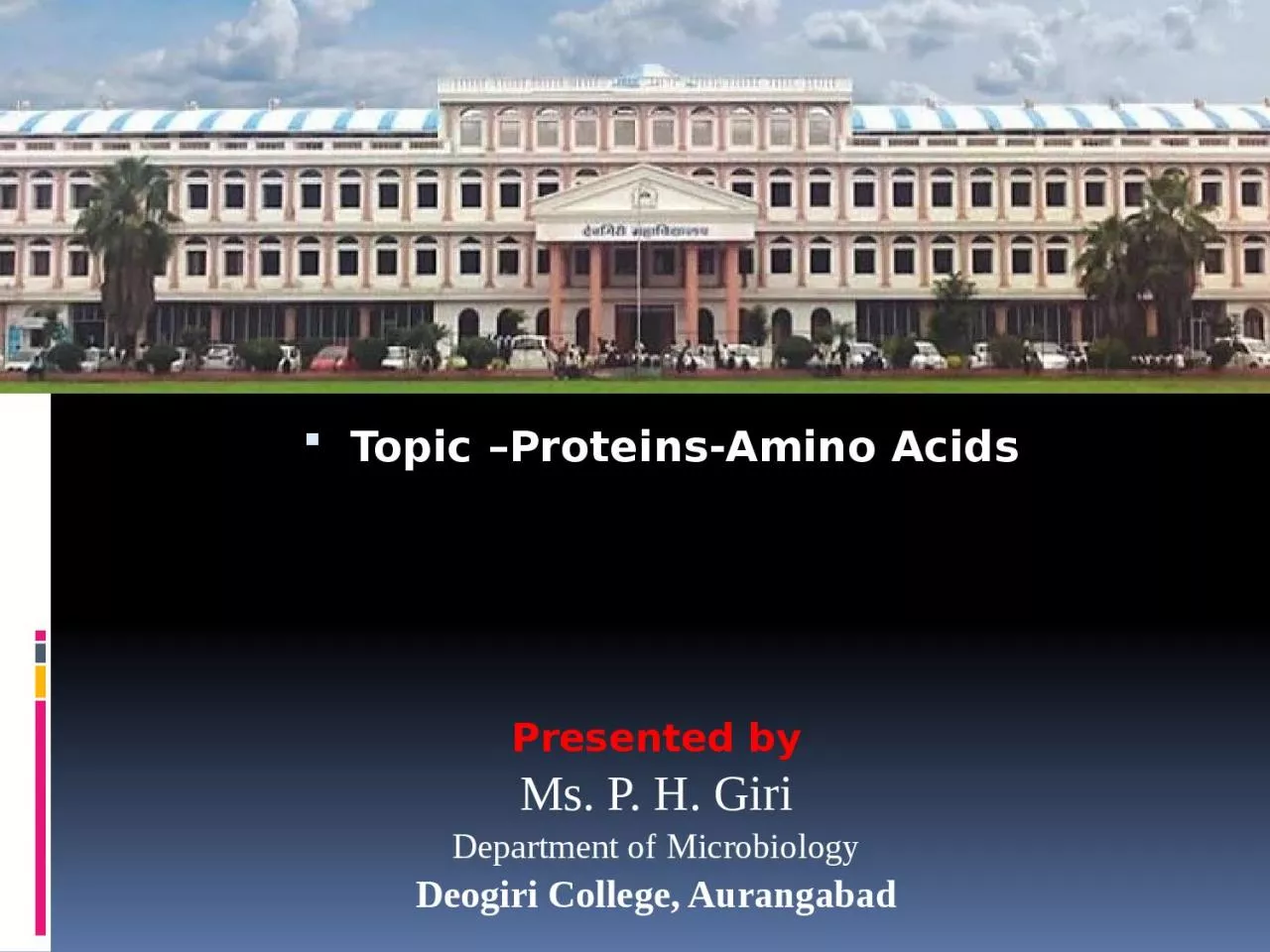

Presented by Ms P H Giri Department of Microbiology Deogiri College Aurangabad BSc F Y Semester II Paper No V Basic Biochemistry Unit 3 Proteins Ms Priyanka H Giri ID: 929941
Download Presentation The PPT/PDF document "Topic – Proteins-Amino Acids" is the property of its rightful owner. Permission is granted to download and print the materials on this web site for personal, non-commercial use only, and to display it on your personal computer provided you do not modify the materials and that you retain all copyright notices contained in the materials. By downloading content from our website, you accept the terms of this agreement.
Slide1
Topic –Proteins-Amino AcidsPresented byMs. P. H. GiriDepartment of MicrobiologyDeogiri College, Aurangabad
Slide2B.Sc. F. Y.Semester IIPaper No. VBasic BiochemistryUnit 3 ProteinsMs. Priyanka H. Giri
Slide3INTRODUCTION:The term ‘protein’ is derived from the Greek word - ‘Proteios’ meaning 'primary' or 'holding first place.'Proteins are the chief constituents of all living matter. They contain - C, H, N, and S and sometimes phosphorus also.Proteins may be defined as, 'the high molecular weight mixed polymers of α-amino acids, joined together with peptide (-CONH—) linkage.It may also be defined as, 'the complex nitrogenous substances which are found in the all biological systems.
Slide4AMINO ACIDS:Amino acids are the compounds containing one or more amino groups and one or more carboxyl group in the same molecule.' They are usually classified into α, β, γ - etc., according to the relative positions of the two functional groups.Generally, amino acids can be represented by the structure -
Slide5From the nutritional point of view amino acids are of two types:(1) Essential or indispensable amino acids(2) Non-essential or dispensable amino acids
Slide6Essential or indespensable amino acids:Essential amino acids are those which cannot be synthesized by the animal organisms from substances ordinarily present in the diet, at a speed commensurate with normal growth and hence are always supplied to organism in the form of dietary proteins.There are eight essential amino acids which have special importance to human beings. These are - (1) Valine (2) Leucine (3) Isoleucine(4) Phenylalanine (5) Threonine (6) Methionine(7) Tryptophan (8) Lysine
Slide7Adequate amount of essential amino acids are required to maintain the proper nitrogen balance, otherwise the deficiency of which may cause - nervous breakdown, inhibition of full mental growth, and even may cause death in young ones with complete deficiency.
Slide8Non-essential or dispensable amino acids :Non-essential amino acids are those which can be synthesized by the body and hence are not requisite components of the diet.These amino acids are derived from the carbon skeleton's of lipids and carbohydrate metabolism or from the transformation of essential amino acids.Non-essential amino acids may be synthesized in individual cells from simple starting materials containing - C, H, O, S and N. In human beings there are Twelve non-essential amino acids which have special significance for the human beings. These are -(1) Alanine (2) Argenine 3) Aspartic acid (4) Aspargine (5) Tyrosine (6) Cysteine (7) Glutamic acid (8) Glutamine (9) Glycine (10) Histidine (11) Proline (12) Serine
Slide9CLASSIFICATION OF AMINO ACIDS:Depending on their reaction in solution, amino acids can be classified into three groups.(I) Neutral (II) Acidic (III) Basic
Slide10Slide11PHYSICAL AND CHEMICAL PROPERTIES OF AMINO ACIDS:(1) Solubility: All amino acids are soluble in water.(2) Optical activity: All standard amino acids except glycine have an asymmetric carbon atom. Due to this amino acids are optically active.(3) Acid - Base Behaviour: Amino acids contain both the acidic and basic groups which are ionizable. The amino acids behave as 'amphoteric electrolytes and give both anions and cations in solution, i.e. Zwitterions, in which proton from the carboxyl group has been transferred to the amino group and thus a dipolar (Zwitterion) ion contains both a positive and a negative charge.
Slide12Slide13An electrolytic behaviour of the amino acids in different media:In an acidic solution, an amino acid behaves as a protonated derivative and hence migrages to the cathode; while in alkaline solution the same amino acid behaves as an anion derivative and hence migrates to the anode.
Slide14With the addition of proton to an amino acid converts it into cation, while the addition of base converts it into an anion, hence it is expected that at a definite pH value, the acidic and basic properties of the amino acid must be balanced and hence electrically neutral. This pH at which it gives off equal no. of anions and cations and does not migrate when subjected to electric field is referred as the 'isoelectric pH' of that amino acid. And the point of the pH, at which there is no net charge on the amino acid molecule and which does not migrate to any electrode under the influence of electric current is known as 'isoelectric point'.